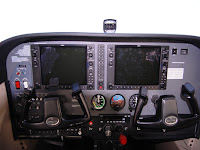 |
| What I'm used to |
 |
| See the difference? |
I think in the end my biggest aversion to them is that people think they're a huge leap forward in aviation. Don't get me wrong the features (lean assist, among several others) are awesome to reduce workload and optimize performance, but there's something to be said for not putting too much faith in technology. I'd prefer not to be in the soup with only the basic three instruments. For those wanting to go down the "it's what the airlines have" route, you're right, but they also often have dual generators, dual batteries, and so on. In any case, I'm making it out to be a bigger deal than it really is, especially now, since I don't have my instrument rating anyway. It's just an I-work-too-much-with-computers-to-fully-trust-them thing.
During the flight, as I was poking around at the displays, with my eyes distinctly not outside, I figured I might as well get some hood time, so I threw the hood on to start logging. We tracked the Martinsburg VOR (MRB - a radio beacon), flew headings, and otherwise just prodded the screen to see what it would do for us. One of the extra features Thomas managed to find was the XM Radio, so we listened to some of that before heading back in to Leesburg (JYO). For those of you wondering how we hear ATC or other people on the frequency while blasting ourselves with XM Radio, it has auto-interrupt when it senses a transmission on the frequency.
By the end of the flight, I came to like the G1000, but I'm still not going out of my way to fly an aircraft with it installed. Then again, I won't specifically avoid it. That gets me thinking, though. Because I just displayed an aversion to new technology, does that mean I'm getting older? I'll tell myself no, since I used it with relative ease (if you've used a G530 before, you'll be relatively at home here), but who knows.
Hours:
Pilot in Command Cross Country (PIC XC): 0 - 31.8 (of 50)
Actual/Simulated Instrument (Act/Sim): 0.3 - 4.2 (of 40)